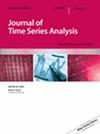随机波动模型的依赖特性
IF 1
4区 数学
Q3 MATHEMATICS, INTERDISCIPLINARY APPLICATIONS
引用次数: 0
摘要
过去二十年来,物理依赖性和近似性的概念被广泛用于量化时间序列中的非线性依赖性。我们的研究表明,大多数随机波动模型都满足这两个依赖条件,即使它们的实现值是在抽象的希尔伯特空间中,从而涵盖了单变量、多变量和函数模型。我们的结果可用于将为伯努利变换建立的多种推论程序应用于一般随机波动模型。本文章由计算机程序翻译,如有差异,请以英文原文为准。
Dependence properties of stochastic volatility models
The concepts of physical dependence and approximability have been extensively used over the past two decades to quantify nonlinear dependence in time series. We show that most stochastic volatility models satisfy both dependence conditions, even if their realizations take values in abstract Hilbert spaces, thus covering univariate, multi-variate and functional models. Our results can be used to apply to general stochastic volatility models a multitude of inferential procedures established for Bernoulli shifts.
求助全文
通过发布文献求助,成功后即可免费获取论文全文。
去求助
来源期刊

Journal of Time Series Analysis
数学-数学跨学科应用
CiteScore
2.00
自引率
0.00%
发文量
39
审稿时长
6-12 weeks
期刊介绍:
During the last 30 years Time Series Analysis has become one of the most important and widely used branches of Mathematical Statistics. Its fields of application range from neurophysiology to astrophysics and it covers such well-known areas as economic forecasting, study of biological data, control systems, signal processing and communications and vibrations engineering.
The Journal of Time Series Analysis started in 1980, has since become the leading journal in its field, publishing papers on both fundamental theory and applications, as well as review papers dealing with recent advances in major areas of the subject and short communications on theoretical developments. The editorial board consists of many of the world''s leading experts in Time Series Analysis.
 求助内容:
求助内容: 应助结果提醒方式:
应助结果提醒方式:


